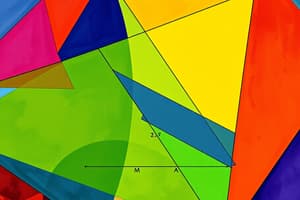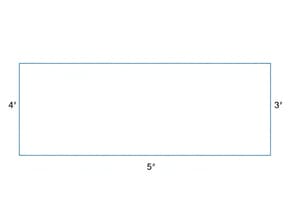Podcast
Questions and Answers
Which geometric shape mentioned in the text has a larger perimeter but the same area as a circle?
Which geometric shape mentioned in the text has a larger perimeter but the same area as a circle?
- Rectangle
- Triangle
- Square (correct)
- Pentagon
In real-life applications, why do engineers and architects need to consider both the area and perimeter of spaces?
In real-life applications, why do engineers and architects need to consider both the area and perimeter of spaces?
- To reduce property taxes
- To ensure aesthetic appeal
- To simplify calculations
- To optimize design and materials usage (correct)
Why might a shape with a large perimeter not necessarily have a large area?
Why might a shape with a large perimeter not necessarily have a large area?
- It could be a circle (correct)
- It lacks symmetry
- It is poorly designed
- It has many sides
When calculating perimeter, why does a circle have a smaller perimeter compared to a square of equal area?
When calculating perimeter, why does a circle have a smaller perimeter compared to a square of equal area?
How do understanding the concepts of perimeter and area help in real-life situations according to the text?
How do understanding the concepts of perimeter and area help in real-life situations according to the text?
What is the formula to calculate the perimeter of a rectangle?
What is the formula to calculate the perimeter of a rectangle?
How is the area of a circle calculated?
How is the area of a circle calculated?
When calculating the perimeter of a shape, what do you need to do with the lengths of its sides?
When calculating the perimeter of a shape, what do you need to do with the lengths of its sides?
Which statement correctly describes the relationship between perimeter and area?
Which statement correctly describes the relationship between perimeter and area?
What would be the correct formula for calculating the area of a rectangle?
What would be the correct formula for calculating the area of a rectangle?
Flashcards are hidden until you start studying
Study Notes
Perimeter and Area
Shapes have two fundamental properties that help us describe, measure, and analyze them: perimeter and area. Let's explore these concepts in detail.
Perimeter
The perimeter of a shape is the distance around its boundary, which is also referred to as its length. To find the perimeter, we simply add up the lengths of all its sides.
For example, the perimeter of a rectangle is calculated by adding the length of its sides: Perimeter = Length + Width.
The formulas for perimeter vary depending on the shape. For example, the perimeter of a circle is Perimeter = π * Diameter, or Perimeter = 2 * π * Radius.
Area
The area of a shape is the amount of space it occupies, often measured in square units (e.g., square centimeters or square meters).
For rectangles, the area is calculated by multiplying the length and width: Area = Length * Width.
Circles have a more complex formula for area: Area = π * Radius^2.
Calculating Perimeter and Area
To calculate perimeter and area, follow these steps:
- Identify the shape and determine its formulas for perimeter and area.
- Measure the dimensions of the shape (length, width, radius, etc.).
- Plug the dimensions into the appropriate formula.
The Relationship between Perimeter and Area
Perimeter and area are not directly related, but they can provide insights into a shape's properties.
For instance, if a shape has a large area, it will likely have a larger perimeter. However, a shape with a large perimeter may not necessarily have a large area.
For example, compare a square and a circle of equal area. The square has a larger perimeter because it has more sides. However, the circle has a smaller perimeter, even though they both have an equal amount of space.
Applications of Perimeter and Area
Perimeter and area are essential concepts in geometry, but they also find practical applications in real life.
- Construction: When designing a building or a park, engineers and architects must consider the area and perimeter of different spaces to ensure efficient use of the available space.
- Land valuation taxation: Property tax assessments often take into account the area and perimeter of a property when determining its value.
- Engineering: To minimize costs, engineers may need to determine the area and perimeter of various structures to optimize their design and materials usage.
In summary, perimeter and area are fundamental concepts in geometry that help us describe and analyze shapes. By understanding these concepts and their application, we can develop problem-solving skills, understand spatial relationships, and apply geometry to real-life situations.
Studying That Suits You
Use AI to generate personalized quizzes and flashcards to suit your learning preferences.




